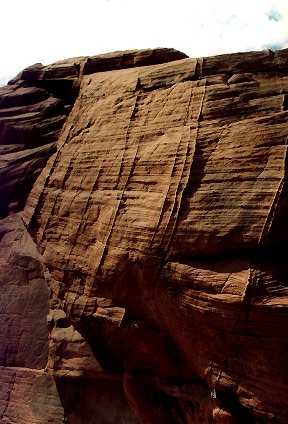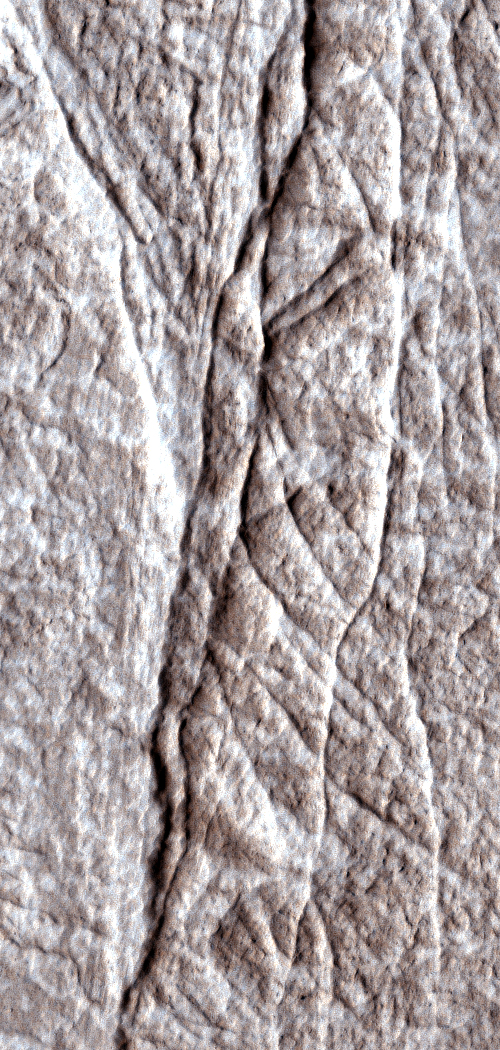[/caption]
NASA’s Mars Reconnaissance Orbiter has revealed hundreds of small fractures exposed on the Martian surface that billions of years ago directed flows of water through underground Martian sandstone. Researchers used images from the spacecraft’s HiRISE (High Resolution Imaging Science Experiment) camera. Images of layered rock deposits at equatorial Martian sites show the clusters of fractures to be a type called deformation bands, caused by stresses below the surface in granular or porous bedrock. “Groundwater often flows along fractures such as these, and knowing that these are deformation bands helps us understand how the underground plumbing may have worked within these layered deposits,” said Chris Okubo of the U.S. Geological Survey in Flagstaff, Ariz.
Visible effects of water on the color and texture of rock along the fractures provide evidence that groundwater flowed extensively along the fractures. “These structures are important sites for future exploration and investigations into the geological history of water and water-related processes on Mars,” Okubo and co-authors state in a report published online this month in the Geological Society of America Bulletin.

Deformation band clusters in Utah sandstones, as on Mars, are a few meters or yards wide and up to a few kilometers or miles long. They form from either compression or stretching of underground layers, and can be precursors to faults. The ones visible at the surface have become exposed as overlying layers erode away. Deformation bands and faults can strongly influence the movement of groundwater on Earth and appear to have been similarly important on Mars, according to this study.
“This study provides a picture of not just surface water erosion, but true groundwater effects widely distributed over the planet,” said Suzanne Smrekar, deputy project scientist for the Mars Reconnaissance Orbiter at NASA’s Jet Propulsion Laboratory in Pasadena, Calif. “Groundwater movement has important implications for how the temperature and chemistry of the crust have changed over time, which in turn affects the potential for habitats for past life.”
Deformation bands form when sections of rock slide past each other and are similar to faults, such as the much larger San Andreas Fault in southern California. The discovery of deformation bands in HiRISE images advances understanding of how underground fractures would have affected the distribution and availability of ancient groundwater on Mars.
The HiRISE camera took the top image of layered rocks inside a crater in the Arabia Terra region of Mars on Feb. 13, 2007. The site is at 6.6 degrees north latitude, 14.1 degrees east longitude. Illumination is from the left. North is toward the top. The ground covered in this image spans about 150 meters (about 500 feet) east to west.
Source: NASA


I am always skeptical about these reports of new evidence of ground water flow on mars. The images show fissures but they never look like drainage patterns on earth, nor are they correlated with elevation data to show if they even drain anywhere. Many of the larger and more famous examples can be shown to have narrow, thinning ends on both ends rather than outlets and deltas that dump into basins.
This article even goes so far as to state that the fissures are probably created by subsurface geologic forces. Furthermore, if the fissures were formed “billions of years ago” “through underground Martian sandstone” and Mars in only 4.6 billion years old, that didn’t leave much time for the sandstone to have formed.
I am pretty sure that we will find that these fissures were formed by plate techtonics prior to 4 bY and since have been shaped by wind and blowing sand shaping them into channels. The fact that they aren’t more defined is testament to the planet’s thin atmosphere and thus much slower rate of erosion.
I have nothing against the theories of surface water on mars but the evidince I continue to see makes me think that we are looking for evidence of things we want to find rather than doing good, objective science.
~D